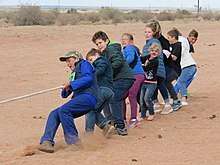White Namibians
White Namibians are people of European birth or descent living in Namibia. The majority of White Namibians are Afrikaners (locally born or of South African descent), with many of the White minority being German Namibians (descended from Germans who colonised Namibia in the late-nineteenth century). Many are also Portuguese or English immigrants. Current estimates of the White Namibian population run between 75,000[1] and 100,000.[2] This discrepancy in data is because the Namibian government no longer collects data based on race.
Blanke Namibiërs, Wit Namibiërs | |
|---|---|
 Afrikaner children playing tug of war during a traditional boeresport day in Namibia. | |
| Total population | |
| 200,000 | |
| Regions with significant populations | |
| 152,000 | |
| Others | 48,000 |
| Languages | |
| First language Afrikaans (60%), German (32%), English (7%), Portuguese (1%) | |
| Religion | |
| Predominantly Christianity | |
| Related ethnic groups | |
| White South Africans, Coloureds, Afrikaners, other White Africans | |
Distribution
The vast majority of White Namibians live in major cities and towns in central or southern Namibia. Windhoek has by far the largest White population, and Whites are a majority in the coastal city of Swakopmund. Other coastal cities, such as Walvis Bay and Lüderitz, also have large White communities. In general, most of Namibia south of Windhoek has a high proportion of Whites, while central Namibia has a high concentration of Whites. Apart from Windhoek, coastal areas and Southern Namibia, there are large White communities in Otjiwarongo and towns in the Otavi Triangle, such as Tsumeb and Grootfontein. The 1981 census of the Republic of South Africa reported a White population of 76,430 in Namibia (71% Afrikaners and 17% German-speaking).[3]
History
During Namibia's German rule, the colony attracted German immigrants. Most Afrikaners settled during the Dorsland Trek, as well as during the existence of apartheid. Most Angolan-born Portuguese settled after Angola became independent in 1975.
Economics
About 4,000 commercial land owners, mostly Whites, own around 50% of the arable land across the country despite a land reform process.[4] According to the FAO, around 42% of arable land was owned by Whites at the time of independence in 1990.[5] While the area was known as South West Africa, white Namibians enjoyed a highly privileged position due to apartheid laws enforcing strict segregation.[6]
Politicians
- Leon Jooste, Minister of Public Enterprises
- Anton Lubowski, political activist
- Dirk Mudge, Chairman of the Turnhalle Constitutional Conference
- Henk Mudge, Member of Parliament
- Kosie Pretorius, Member of Parliament
- Hanno Rumpf, government minister and ambassador
- Hans Erik Staby, Member of Parliament
- Jan de Wet, Member of Parliament
- Piet van der Walt, Deputy Minister of National Planning
- Calle Schlettwein, Minister of Finance
- Nico Smit, Member of Parliament
Businessmen
Sportsmen
Sportswomen
Writers
Farmers
Scientists
- Japie van Zyl[8]
Others
- Michelle McLean (fashion model)
- Behati Prinsloo (fashion model and Victoria's Secret angel)
Population chart
| Government | Year | White population | Total population | White in percent |
|---|---|---|---|---|
| German South West Africa (1884–1915) | ||||
| South West Africa, South African administration (1915–1990) | 1918 | 13,400[9] | 195,000* | 7% |
| 1919 | 6,700[10] | 205,000* | 3% | |
| 1921 | 19,432[11] | 228,910[12] | 8% | |
| 1933 | 10,000[10] | 290,000* | 3% | |
| 1958 | 66,000[11] | 561,854[13] | 12% | |
| 1965 | 68,000[14] | 670,981[13] | 10% | |
| 1981 | 76,430[3] | 1,033,196[15] | 7% | |
| Republic of Namibia (1990–) | 2011 | 75,000 – 120,000 | 2,113,077 | 4–7% |
References
- Namibian.org – retrieved 3 February 2016
- Namibia-Travel – retrieved 3 February 2016
- Weigend, Guido G. (April 1985). "German Settlement Patterns in Namibia". Geographical Review. 75 (2): 156–169. JSTOR 214466.
- Namibians plan white farm grabs in BBC News, 5 November 2003
- Garcia, C. Tapia. "Land Reform / Réforme agraire / Reforma agraria /". Food and Agriculture Organization. Retrieved 26 March 2017.
- Amid Namibia's White Opulence, Majority Rule Isn't So Scary Now in the New York Times, 26 December 1988
- Risser, Namibia's White Warrior FIFA, 23 January 2008
- "Dr. Japie van Zyl". www.jpl.nasa.gov. Retrieved 13 July 2017.
- Garvey, Marcus (5 November 1995). The Marcus Garvey and Universal Negro Improvement Association Papers, Vol. IX: Africa for the Africans June 1921 – December 1922. University of California Press. ISBN 9780520916821.
- Hackl, Dietmar. "History of Namibia – The Independence". www.namib.info. Retrieved 2 September 2015.
- Jeremy, Silvester (13 July 2015). Re-Viewing Resistance in Namibian History. University of Namibia Press. ISBN 9789991642277.
- "An atlas of Namibia's population: monitoring and understanding its characteristics" (PDF). Namibia Central Bureau of Statistics. 2010.
- "Namibia Population 1950 – 2050". www.bluemarblecitizen.com. Retrieved 2 September 2015.
- "Namibia Virtual Jewish History Tour | Jewish Virtual Library". www.jewishvirtuallibrary.org. Retrieved 2 September 2015.
- "Population – Namibia – Africa". www.countriesquest.com. Retrieved 2 September 2015.